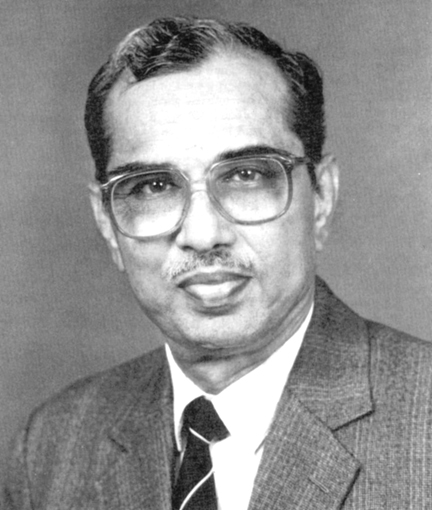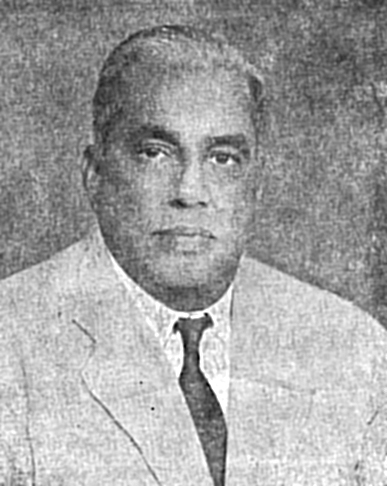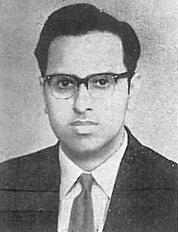|
(Continued from last fortnight)

Dr. R. Venkataswami
|
Pioneering Hand and Reconstructive Surgeon Dr. R. Venkataswami came from Kothaneri, a village where there were no schools with classes above the 5th Standard. He had to walk daily about 3½ miles to Gobinaickenpatti, near Coimbatore, for further studies. "Rather strangely the first teacher I met there was a Mr. Stanley from Nagercoil, very strict, and always in a suit!" he remembers.
Following a stint at the R.K. Mission School in Coimbatore, Dr. Venkataswami enrolled in Loyola College for BA Hons. Within 10 days, however, he left for Medical College. He had attended the interview in 1951 in a borrowed suit and was admitted as a first generation learner!
"It was a wonderful learning atmosphere; the teachers were kind and friendly, we had students from all States. We learnt character and discipline, and had opportunities to listen to the most amazing speakers – Aneurin Bevan, the British Minister who initiated the National Health Service, Sir Alexander Fleming, Sir Lakshmanaswami Mudaliar, and others. Ananthanarayana Iyer, who taught us Anatomy, was brilliant; his lectures were orations on the subject. We were encouraged to participate in a lot of cultural activities too. I was General Secretary of the College Union in 1953. Prathap Reddy, now the Chairman of Apollo Hospitals, was my classmate, I remember him initiating the formation of a city college union at the time!
"When I passed my M.S., I joined Dr.A.S. Ramakrishnan at the General Hospital. An exceptional surgeon, he felt using antibiotics for elective surgery was unnecessary; infection-free surgeries were his forte. Tissues actually opened before him! Following a stint at the Erskine (now Rajaji) Hospital in Madurai, I joined Stanley. In 1956, I had the opportunity of listening to Sir Harold Gilles, the father of modern Plastic Surgery. Later, inspired by the skill of -renowned plastic surgeon Dr. C. Balakrishnan in reconstructing badly mutilated hands at the Plastic Surgery Institute, Nagpur, I yearned to start a plastic and reconstructive surgery unit at Stanley. The existence of just only one plastic surgery centre in the country and the location of Stanley in an industrial hub with a high incidence of industrial accidents were compelling reasons.
"In 1967, I met the Dean, Dr. Prabhu, with a request to start such a unit. When asked to submit a proposal in three hours, I did so recommending 1 HOD, 1 Assistant, 4 Staff Nurses and 20 beds. The plastic surgery unit at Stanley officially began in 1971. As far as space was concerned, only corridors were free. After a meeting with my seniors, we decided to start a nucleus in Ward 13, the Wilson Ward, with four beds. The other 16 beds were across eight wards. But where to operate? We managed to share two operation days with others for elective surgery.
"As the team had to be ready at all times, we decentralised our work procedure and equipment. Emergency surgery was carried out in a corridor of Wilson Ward, a verandah that was converted into an operation theatre which included an emergency theatre, 19ft by 8ft!
"Dr. Naik and I meticulously recorded all that we did, and you will still find handwritten details of even our first patient in the Hospital. We performed over 1000 hand surgeries in the first month! We approached Health Minister Anbazhagan to sanction the Hand Injury Service Department; we didn't want an additional building, only more staff. We added a ward from donations, got a microscope, and a team of committed assistants," reminisces Dr. Venkataswami.
An innovative idea, mainly to get illiterate patients to opt for plastic surgery as quickly as possible was the famous red line painted all the way from the Casualty to the Plastic Surgery Department with instructions in Tamil and English to 'follow the red line'. "Our team met for review each day at 8.30 am sharp, created our own Rehab Centre, even tied up with Transport Department to give patients easy access through buses to hospitals."
In 1973, the Hand Injury Service Centre, the first in the country, was started. Five years later, it was noted that Dr. Venkataswami and his team had performed more than 30,000 hand surgeries. In 1980, the Centre introduced microsurgery for hand injuries, the first in the country. In 1987, the Department was upgraded as the Institute for Research and Rehabilitation of Hand and the Department of Plastic Surgery. "By 1991 we had 80 beds, and 110 staff members, accomplished over 1½ lakh surgeries in five operating suites within our set-up – two for Hand Surgery, two for General Plastic Surgery and one for Microsurgery." Today the Institute has performed more than 330,000 hand injury surgeries and more than 70,000 plastic surgeries, and is even slated to perform the first hand transplant.
His life lessons: "Public institutions are best places for service and commitment. Unitary control which is responsive to suggestion is the best form of management. And to collect a committed team around you, always!"

Dr. R. Raghavachari
|
Dr. R. Raghavachari and Dr. A.S. Ramakrishnan were teachers who inspired Dr. Venkataswami. Passionate about theatre as much as surgery, Dr. Raghavachari spearheaded the Stanley theatre group. Particularly fond of staging Tamil plays like Sivakamiyin Sabadam and Parthiban Kanavu, historical fictions written by Kalki Krishnamurthi, Dr. Venkataswami played the lead roles in all the productions, and acted as the revolutionary Tamil poet Subramania Bharati in the eponymous play scripted by renowned Tamil film director A.C. Tirulokachander.
Staged at the All India Congress Committee session at Avadi in 1955, it was witnessed by Prime Minister Jawaharlal Nehru himself!
'The Tempo of learning was brilliant'
 Dr. K.V. Thiruvengadam. |
Among the oldest living Stanleans is eminent physician and Padma Sri awardee 85-year-old Dr. K.V. Thiruvengadam, popularly known as Dr. KVT, who was an undergraduate student from 1945 to 1950 and later Vice-Principal and Professor of Medicine for 11 years from 1959 to 1975. Dr. KVT, a physician and clinician whose skills are the last word in diagnosis has been witness to an era in medicine – from excited professors holding up a vial of chloramphenicol with reverence to the present interesting developments in telemedicine.
Dr. KVT reminisces, "I had finished my B.Sc Chemistry and was being interviewed for entry to an engineering course in Guindy Engineering College. My impressive marks in Human Physiology prompted the legendary Sir A.L. Mudaliar (then on the interview panel) to persuade me to apply for medicine and so I joined Madras Medical College, though it happened to be just for 20 days. On the next day, a cycle messenger came over from Stanley and informed me that if I did not report the next morning at Stanley Medical College, my medical course admission would be cancelled! Only then, I realised that a letter had been sent transferring me to SMC (and it had languished unattended in my letter box). The transfer was necessitated because MMC wanted to replace me with another medical student who was also a good footballer (then much needed by MMC). However, to my dismay, I was asked to pay fees again, though I'd already paid up at MMC. The kind Vice-Principal loaned me Rs.120 to meet it.
"SMC was a comparatively young college. With fewer students, the bedside clinics were more effective. The tempo of learning was brilliant, with inspiring teachers and challenging peers. Dr. Raghavachari taught Surgery as no one could. He held us spellbound for three hours with a weekend line-up of patients on verandahs so that we could learn better! His methodology was so standar-dised that students could not fail."
In 1950, KVT passed his MBBS with a first class, though just one mark short of a distinction. "First classes were rare, about once in ten years! For our Anatomy classes, we had to go to MMC. Though MMC had the cream of students, those from Stanley topped many times! Our teachers taught by example the ethics of medical practice, professional and personal character!"
The 'Best Outgoing Student of the 1945 batch' singled out exemplary teachers such as Dr. K.S. Sanjivi, Dr. Rathnavel Subramanian, Dr. Arunachalam and Dr. R. Raghavachari as inspirations. "The only days Dr. Raghavachari would not teach were the Test match days, for he was a cricket enthusiast!"
It was well into World War II before antibiotics reached Madras for the first time. "Those days we had to wear masks while opening a vial! Streptomycin was to be used selectively and chloramphenicol for treatment of typhoid had to be reverently handled." Dr. KVT also remembers the inauguration of the new outpatient block held in the late 1960s, the building of the new surgical block behind the demolished Gray Ward where, he recalls, French nuns were looking after the terminally ill, the development of Paediatrics as a distinct speciality with Dr. A.T. John as the first paediatrician in the hospital, and the emergence of the Medical Oncology block.
When Dr. KVT was Vice-Principal, Dr. A.N.K. Menon was Dean, and Dr. Kutumbiah, the Principal and "the office a well oiled machine"! His eyes sparkle as he remembers eminent stalwarts like Dr. Mahadevan, the first surgeon to open the heart in the 1940s, Dr. Kini, an ortho-surgeon of outstanding ability, Prof. Ananthanarayanan ("who had a wonderful way of teaching Anatomy, especially embryology. With no slides or powerpoint projectors at that time, he could put romance even into Embryology"). Gynaecologist Dr. Madhavan, known for his sartorial elegance, "used to come any time at night, very fast in his Vauxhall car" and J.P. Valiath was an extremely empathetic teacher. He, finally, comments, "In Government service, if you have the will you can do a lot of work. Many of our patients were very poor, had to be housed on cots and below cots. Many times, with no money even to go home! From Poor Fund, it'd take a long time to get funds. So we'd reimburse them most times!"
(To be concluded)
|